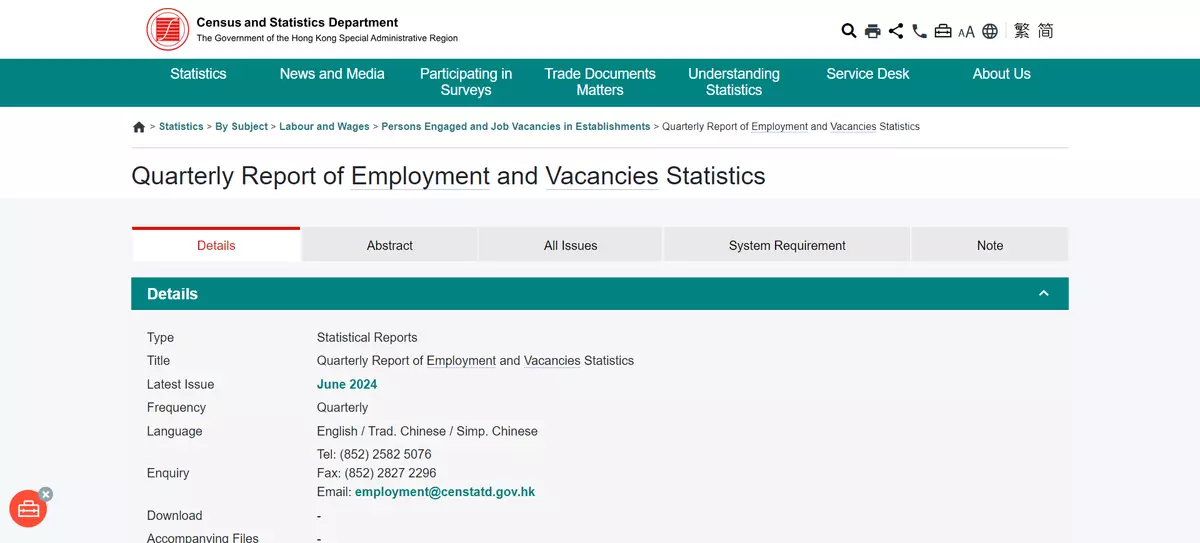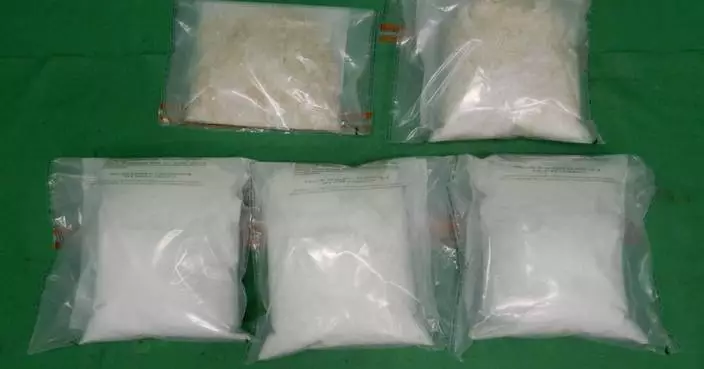Employment and vacancies statistics for June 2024
According to the figures released today (September 20) by the Census and Statistics Department (C&SD), total employment in the private sector surveyed decreased by 0.5% or 14 200 persons in June 2024 compared with a year earlier. The total number of vacancies was 69 440, representing a decrease of 15% or 12 020 over the preceding year.
Employment statistics
In June 2024, the selected industries as a whole employed 2 724 100 persons. The import and export trade engaged 357 200 persons, followed by professional and business services (excluding cleaning and similar services) engaging 313 500 persons, retail trade 239 100 persons, financing and insurance 229 300 persons, and food and beverage services 223 700 persons.
Movements in the employment in different surveyed industries varied when compared with a year earlier. Decreases were mainly observed in the industries of wholesale (-6.1% or -3 100 persons), retail trade (-5.1% or -12 800 persons), import and export trade (-5.0% or -18 900 persons), and cleaning and similar services (-4.3% or -3 600 persons). On the other hand, employment increased mainly in the industries of construction sites (manual workers only) (11.8% or 13 100 persons), and residential care and social work services (4.3% or 3 100 persons). Employment figures for selected major industries are shown in Table 1.
Vacancies statistics
Among the 69 440 private sector vacancies in June 2024, 7 640 were from the industry of transportation, storage, postal and courier services; 7 120 from professional and business services (excluding cleaning and similar services); 6 890 from education; and 5 680 from food and beverage services.
Vacancies decreased in majority of the selected industries in June 2024 over a year earlier. Decreases were mainly observed in the industries of retail trade (-2 660 or -40%), education (-2 250 or -25%), financing and insurance (-1 450 or -23%), and arts, entertainment, recreation and other services (-1 370 or -25%). On the other hand, vacancies increased mainly in the industries of transportation, storage, postal and courier services (620 or 9%), and import and export trade (310 or 8%). Job vacancies figures for selected major industries are shown in Table 2.
Analysed by major occupation category, private sector vacancies were observed mainly in the categories of service and sales workers (25 760 vacancies), professionals (11 400 vacancies), and associate professionals (10 080 vacancies). Job vacancies figures by major occupation category are shown in Table 3.
Seasonally adjusted statistics
For discerning the latest trend in employment and vacancies in the private sector, it is useful to look at changes over a three-month period in the respective seasonally adjusted figures. Compared with March 2024, the seasonally adjusted total employment and total vacancies in the surveyed industries decreased by 0.2% and 8.1% respectively in June 2024. The changes over three-month periods in the seasonally adjusted series of employment and vacancies are shown in Table 4.
Other information
The above employment and vacancies statistics were obtained from the Quarterly Survey of Employment and Vacancies and the Quarterly Employment Survey of Construction Sites conducted by the C&SD. In the former survey, some economic activities (e.g. those dominated by self-employment, including taxi operators and hawkers) are not covered. Therefore, the respective employment and vacancies figures relate only to those selected industries included in the survey. In the latter survey on construction sites, employment and vacancies figures relate to manual workers only.
A detailed breakdown of the above statistics is published in the following reports:
"Quarterly Report of Employment and Vacancies Statistics, June 2024"
(www.censtatd.gov.hk/en/EIndexbySubject.html?pcode=B1050003&scode=452)
"Quarterly Report of Employment and Vacancies at Construction Sites, June 2024"
(www.censtatd.gov.hk/en/EIndexbySubject.html?pcode=B1050004&scode=452)
Users can browse and download these publications at the website of the C&SD.
Enquiries on more detailed employment and vacancies statistics can be directed to the Employment Statistics Section of the C&SD (Tel: 2582 5076 or email: employment@censtatd.gov.hk).








